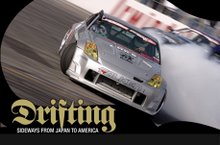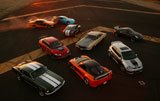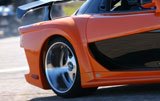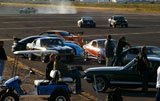 Testing the bad guy's turbocharged Nissan from The Fast & the Furious: Tokyo Drift
Testing the bad guy's turbocharged Nissan from The Fast & the Furious: Tokyo DriftEvery movie has a protagonist (the hero) and an antagonist (the bad guy). While the protagonist ends up with the girl, it always seems the antagonist has more fun. In The Fast & The Furious: Tokyo Drift the bad guy is "The Drift King," and his ride is this twin-turbo Nissan 350Z. That's fun.Eleven 350Zs actually portrayed the Drift King's mount — including those built to wreck. And this is one of the two primary cars equipped with an APS twin-turbo system (a $7,500 kit through most shops) breathing into the 3.5-liter DOHC 24-valve V6 engine. With APS's turbo-back exhaust system and some Magnaflow mufflers to quiet it down, there should be at least 450 horsepower available at the crank in this car. There's probably more.Beaten in every way a car could be, the Tokyo Drift 350Z wore scars along its Veilside Version 3 wide-body kit, but started instantly to settle into a humming idle like a taxiing F-18. The Nissan 350Z is stiff when it's unmodified, and the 19-inch Veilside rims covered with Toyo Proxes 285/30R19 T1Rs and RSR lowering springs make it stiffer. But it's how the pavement crackles and snaps under those as they cross it that gives the twin-turbo 350Z its menace.The Sparco EVO L driver seat won't let anyone with a wide hiney settle in and clamps in on anyone else like a vise grip.  The six-speed transmission feeds back to a Nismo limited-slip differential, which makes launching the car at least straightforward like pulling the hammer of a Glock pistol back into the fully cocked position.The Drift King's 350Z doesn't launch easily; the revs have to stay up for the turbos and it will chatter the rear tires (after all, it was built to slide, not drag race).
The six-speed transmission feeds back to a Nismo limited-slip differential, which makes launching the car at least straightforward like pulling the hammer of a Glock pistol back into the fully cocked position.The Drift King's 350Z doesn't launch easily; the revs have to stay up for the turbos and it will chatter the rear tires (after all, it was built to slide, not drag race).  Still, it screamed to 60 mph in 5.7 seconds and blistered the quarter-mile in 13.2 seconds at 114.8 mph. The last stock 2005 350Z this site tested took 5.9 seconds to reach 60 and 14.6 seconds at 99.3 mph to complete the quarter-mile. With a 0-60 time only two-tenths quicker than stock, and a quarter-mile time nearly 1.4 seconds better, this is a car with more power than it can use off launch.With a little launch control, the twin-turbo Nissan 350Z would be running well in the 12s in the quarter-mile. In The Fast and the Furious: Tokyo Drift, the bad guy may not get the girl, but at least he gets to wherever he's going quickly.
Still, it screamed to 60 mph in 5.7 seconds and blistered the quarter-mile in 13.2 seconds at 114.8 mph. The last stock 2005 350Z this site tested took 5.9 seconds to reach 60 and 14.6 seconds at 99.3 mph to complete the quarter-mile. With a 0-60 time only two-tenths quicker than stock, and a quarter-mile time nearly 1.4 seconds better, this is a car with more power than it can use off launch.With a little launch control, the twin-turbo Nissan 350Z would be running well in the 12s in the quarter-mile. In The Fast and the Furious: Tokyo Drift, the bad guy may not get the girl, but at least he gets to wherever he's going quickly.
 The six-speed transmission feeds back to a Nismo limited-slip differential, which makes launching the car at least straightforward like pulling the hammer of a Glock pistol back into the fully cocked position.The Drift King's 350Z doesn't launch easily; the revs have to stay up for the turbos and it will chatter the rear tires (after all, it was built to slide, not drag race).
The six-speed transmission feeds back to a Nismo limited-slip differential, which makes launching the car at least straightforward like pulling the hammer of a Glock pistol back into the fully cocked position.The Drift King's 350Z doesn't launch easily; the revs have to stay up for the turbos and it will chatter the rear tires (after all, it was built to slide, not drag race).  Still, it screamed to 60 mph in 5.7 seconds and blistered the quarter-mile in 13.2 seconds at 114.8 mph. The last stock 2005 350Z this site tested took 5.9 seconds to reach 60 and 14.6 seconds at 99.3 mph to complete the quarter-mile. With a 0-60 time only two-tenths quicker than stock, and a quarter-mile time nearly 1.4 seconds better, this is a car with more power than it can use off launch.With a little launch control, the twin-turbo Nissan 350Z would be running well in the 12s in the quarter-mile. In The Fast and the Furious: Tokyo Drift, the bad guy may not get the girl, but at least he gets to wherever he's going quickly.
Still, it screamed to 60 mph in 5.7 seconds and blistered the quarter-mile in 13.2 seconds at 114.8 mph. The last stock 2005 350Z this site tested took 5.9 seconds to reach 60 and 14.6 seconds at 99.3 mph to complete the quarter-mile. With a 0-60 time only two-tenths quicker than stock, and a quarter-mile time nearly 1.4 seconds better, this is a car with more power than it can use off launch.With a little launch control, the twin-turbo Nissan 350Z would be running well in the 12s in the quarter-mile. In The Fast and the Furious: Tokyo Drift, the bad guy may not get the girl, but at least he gets to wherever he's going quickly. 




 straight-six from a mid-'90s Nissan Skyline GT-R between its front fenders. And it actually works well.Fortunately for the Tokyo Drift crew, Mustangs were sold with six-cylinder engines, so the engine bay is designed to accept that configuration. Unfortunately, that engine bay was designed back in the '60s, before anyone was using either computers or the metric system in America. And the stock Nissan twin-turbocharger system would have found itself crammed by the left-hand-drive Mustang's steering column. So this Skyline engine uses a single turbo system custom fabricated at the Tokyo Drift shop that incorporates a Sparco intercooler under the front bumper. Otherwise, the engine is very much in the condition it was in when Nissan first built it — including the fact that it's bolted to its original five-speed manual transmission.Though the Skyline GT-R's six carried a 280-horsepower rating when it was sold in Japan, that number has always been low. So it wasn't much of a surprise that the Skyline-powered Mustang showed 340 hp at 7,300 rpm at the rear wheels on the chassis dyno. It also showed a healthy 264 pound-feet of peak torque at 5,950 rpm.Riding on Volk Racing 19-inch wheels and P245/35R19 front and 275/35R19 rear tires, this weird hybrid drives sweetly. The five-speed manual transmission shifts with a light touch, the spool differential in the Ford 9-inch rear end is benign, and the car even rides well despite the fact the suspension was primitive even by 1967 standards.
straight-six from a mid-'90s Nissan Skyline GT-R between its front fenders. And it actually works well.Fortunately for the Tokyo Drift crew, Mustangs were sold with six-cylinder engines, so the engine bay is designed to accept that configuration. Unfortunately, that engine bay was designed back in the '60s, before anyone was using either computers or the metric system in America. And the stock Nissan twin-turbocharger system would have found itself crammed by the left-hand-drive Mustang's steering column. So this Skyline engine uses a single turbo system custom fabricated at the Tokyo Drift shop that incorporates a Sparco intercooler under the front bumper. Otherwise, the engine is very much in the condition it was in when Nissan first built it — including the fact that it's bolted to its original five-speed manual transmission.Though the Skyline GT-R's six carried a 280-horsepower rating when it was sold in Japan, that number has always been low. So it wasn't much of a surprise that the Skyline-powered Mustang showed 340 hp at 7,300 rpm at the rear wheels on the chassis dyno. It also showed a healthy 264 pound-feet of peak torque at 5,950 rpm.Riding on Volk Racing 19-inch wheels and P245/35R19 front and 275/35R19 rear tires, this weird hybrid drives sweetly. The five-speed manual transmission shifts with a light touch, the spool differential in the Ford 9-inch rear end is benign, and the car even rides well despite the fact the suspension was primitive even by 1967 standards.  Of course, it's a nearly 40-year-old Ford, so there are plenty of squeaks and rattles, and the exhaust sounds more like a UPS truck than a high-performance Mustang, but it's a unique and oddly attractive ride. And it was decently quick, too, running to 60 mph in 5.4 seconds and completing the quarter-mile in 13.5 seconds at 109.8 mph.Of course the only reason that this Skyline-powered Mustang exists is because some Hollywood writer imagined it. The question for hot-rodders should be, why didn't any of them think of it first?
Of course, it's a nearly 40-year-old Ford, so there are plenty of squeaks and rattles, and the exhaust sounds more like a UPS truck than a high-performance Mustang, but it's a unique and oddly attractive ride. And it was decently quick, too, running to 60 mph in 5.4 seconds and completing the quarter-mile in 13.5 seconds at 109.8 mph.Of course the only reason that this Skyline-powered Mustang exists is because some Hollywood writer imagined it. The question for hot-rodders should be, why didn't any of them think of it first?
 Underhood, there's a Greddy single-turbo system plumbed into the Renesis rotary engine, with the waste gases channeled through a Tanabe cat-back exhaust system. The RX-8 was lowered using Tein springs, while the interior has a Nardi steering wheel and Takata seatbelts. That hood may look like carbon fiber, but that's really only paint. The Veilside rear wing, on the other hand, is built from genuine carbon fiber.While this right-hand-drive Mazda RX-8 seemed to be in pretty good shape at first glance, the engine was obviously down on power. On the chassis dyno, we only found 191 horsepower at 5,500 rpm making it to the rear wheels, and 187 pound-feet of peak torque at 5,150 rpm. That's less than what would be expected of a stock U.S.-market RX-8 that carries a crank rating of 238 hp at a screaming 8,500 rpm. The turbo system was missing in action on the dyno and somehow most of the engine's top end disappeared, too.So it was surprising when the Tokyo Drift RX-8 slugged its way to 60 mph in 6.7 seconds and completed the quarter-mile in 14.9 seconds at 103.6 mph — better marks than those set by the last stock RX-8_Inside Line test, which hit 60 mph in 7 seconds and ran the quarter in 15.4 seconds at 92.7 mph. Go figure. Maybe that turbocharger showed up after all.Even lowered on oversize wheels and tires, this Mazda RX-8 rode well and remained relatively comfortable on the occasionally choppy surface of the test venue. This is not a hard-edged car, but one that with some expert tuning and extended TLC could be capable of epic performance. That's not what movie companies are in the business of doing, however.
Underhood, there's a Greddy single-turbo system plumbed into the Renesis rotary engine, with the waste gases channeled through a Tanabe cat-back exhaust system. The RX-8 was lowered using Tein springs, while the interior has a Nardi steering wheel and Takata seatbelts. That hood may look like carbon fiber, but that's really only paint. The Veilside rear wing, on the other hand, is built from genuine carbon fiber.While this right-hand-drive Mazda RX-8 seemed to be in pretty good shape at first glance, the engine was obviously down on power. On the chassis dyno, we only found 191 horsepower at 5,500 rpm making it to the rear wheels, and 187 pound-feet of peak torque at 5,150 rpm. That's less than what would be expected of a stock U.S.-market RX-8 that carries a crank rating of 238 hp at a screaming 8,500 rpm. The turbo system was missing in action on the dyno and somehow most of the engine's top end disappeared, too.So it was surprising when the Tokyo Drift RX-8 slugged its way to 60 mph in 6.7 seconds and completed the quarter-mile in 14.9 seconds at 103.6 mph — better marks than those set by the last stock RX-8_Inside Line test, which hit 60 mph in 7 seconds and ran the quarter in 15.4 seconds at 92.7 mph. Go figure. Maybe that turbocharger showed up after all.Even lowered on oversize wheels and tires, this Mazda RX-8 rode well and remained relatively comfortable on the occasionally choppy surface of the test venue. This is not a hard-edged car, but one that with some expert tuning and extended TLC could be capable of epic performance. That's not what movie companies are in the business of doing, however. 
 tial's output assembly with one that leaves out the splines to drive the front wheels and capping the output holes in the transfer case. The stock transverse-mounted six-speed transmission is left alone, as is the rest of the drivetrain. Converting an Evo IX back to all-wheel drive should be just as straightforward.The Tokyo Drift Evo IXs were also lowered over Eibach springs and fitted with APR's wide-body kit and those oversize fenders were filled with 19-by-8.5-inch Ray's G-Games 99B wheels and 255/35R19 Toyo Proxes T1R tires. RMR also modified the steering knuckles for additional angle and upsized the brakes with Brembo discs and calipers.
tial's output assembly with one that leaves out the splines to drive the front wheels and capping the output holes in the transfer case. The stock transverse-mounted six-speed transmission is left alone, as is the rest of the drivetrain. Converting an Evo IX back to all-wheel drive should be just as straightforward.The Tokyo Drift Evo IXs were also lowered over Eibach springs and fitted with APR's wide-body kit and those oversize fenders were filled with 19-by-8.5-inch Ray's G-Games 99B wheels and 255/35R19 Toyo Proxes T1R tires. RMR also modified the steering knuckles for additional angle and upsized the brakes with Brembo discs and calipers.  The turbocharged, 2.0-liter, four-cylinder engines were left essentially stock except for the addition of an RMR exhaust system. Power is up from the stock 286 horsepower at the crank to 289.5 hp at the rear wheels, measured on a chassis dynamometer.With its Modern Image graphics, the Mitsubishi Evo IX looked as if carved from a block of freeze-dried adrenaline: a bundle of nervous energy with four doors and a big wing. Inside, The Fast and the Furious production team replaced the stock instrument cluster with AutoMeter gauges in a carbon-fiber plate and swapped out the steering wheel for a Sparco unit with a quick-disconnect hub. The Recaro seats aren't too radically shaped, but being in this little beast is like sitting on the end of a raw nerve.Lots of power and a mere 103.3-inch wheelbase mean this drift car wants to go sideways all the time — there may as well be windshield wipers on the door windows. So, no surprise, a rear-wheel-drive Mitsubishi Evo is tougher to launch than an all-wheel-drive one, and this one could manage the trip to 60 mph in 6.6 seconds and complete the quarter in 14.5 seconds at 103.6 mph — a slug compared to the 4.9-second 0-60 time and 13.3 seconds at 103-mph performance of the last stock U.S.-market
The turbocharged, 2.0-liter, four-cylinder engines were left essentially stock except for the addition of an RMR exhaust system. Power is up from the stock 286 horsepower at the crank to 289.5 hp at the rear wheels, measured on a chassis dynamometer.With its Modern Image graphics, the Mitsubishi Evo IX looked as if carved from a block of freeze-dried adrenaline: a bundle of nervous energy with four doors and a big wing. Inside, The Fast and the Furious production team replaced the stock instrument cluster with AutoMeter gauges in a carbon-fiber plate and swapped out the steering wheel for a Sparco unit with a quick-disconnect hub. The Recaro seats aren't too radically shaped, but being in this little beast is like sitting on the end of a raw nerve.Lots of power and a mere 103.3-inch wheelbase mean this drift car wants to go sideways all the time — there may as well be windshield wipers on the door windows. So, no surprise, a rear-wheel-drive Mitsubishi Evo is tougher to launch than an all-wheel-drive one, and this one could manage the trip to 60 mph in 6.6 seconds and complete the quarter in 14.5 seconds at 103.6 mph — a slug compared to the 4.9-second 0-60 time and 13.3 seconds at 103-mph performance of the last stock U.S.-market 





